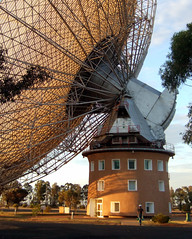

Towards the end of March, Meghan and I drove to Parkes so that I could participate in an observing session. Parkes is a small town about a 6 hour drive from Sydney, deep in central New South Wales, and the
Parkes observatory is even further away, in the quiet Australian countryside. As we got close, the dish was visible on the horizon across acres of open farmland, and when we arrived, we were very excited to see the "Kangaroo Crossing" sign on the observatory grounds. (We spent a while waiting next to this sign, hoping for a kangaroo to hop by: more on that later on.)
The
Parkes radio telescope is huge: 64 meters (or 210 feet) in diameter. It is also fully steerable and has top-notch receivers. With its view of the Southern skies, where the center of our our Galaxy lies, Parkes is one of the most scientifically productive observatories around.
However, one of the biggest claims to fame for Parkes has little to do with astronomy: when Neil Armstrong first walked on the moon on 21st July 1969, the faint television signal from the lunar surface was received by Parkes and relayed, via Houston, to
six hundred million eager viewers around the world. The
story of the broadcast is an extraordinary mix of dazzling technical skill, political elbowing, near-disasters and grace under pressure. It was dramatized in the movie,
The Dish, which is good fun to watch.

When it isn't receiving pictures of the first man on the moon, Parkes is usually doing astronomical observations. Compared to other observatories I've been to, Parkes is unusual in having no operator, just the astronomer on duty and a big red button that has to be pressed every few minutes to verify that they are still awake! I got a crash course in telescope operation, and then it was straight on to an all-night observing session... Hard hats are required on the concrete apron surrounding the telescope, in case a bolt (or worse) falls off the structure: here's a picture of me bringing a hard hat out to Meghan when she dropped by on her morning run, and another of me in the control room after a long night of observing.



When the dish is stowed, it is possible to climb on to the surface, and even to climb to the focus cabin at the very top, where the receivers are housed. I got a chance to make the climb, complete with safety harness, for a quick receiver check. The view out across the plains was beautiful, and looking down was dizzying! (Notice the cars parked at the office building for scale.)
Next to the telescope, the observatory runs a very nice visitor center, and there is also the Dish cafe. Other than that, it is just the astronomers, and the kangaroos. More on that, coming up next.













